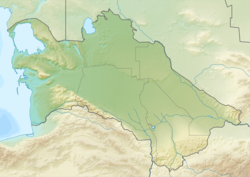| Danata Formation | |
|---|---|
| Stratigraphic range: Early Eocene-Mid Eocene ~ | |
| Type | Geological formation |
| Location | |
| Coordinates | 38°38′N55°48′E / 38.633°N 55.800°E [1] |
| Approximate paleocoordinates | 35°06′N51°12′E / 35.1°N 51.2°E |
| Country | Turkmenistan |
The Danata Formation (or Danatinskaya, Danatinsk, Russian: Danata Svita) is an earliest Eocene to Middle Eocene sedimentary succession located in Turkmenistan. It is mostly famous for its fish-bearing horizons (Ichthyofauna). [1] The formation for example crops out in the Kopet Dag mountain range in the border region of Turkmenistan and Iran. [1] It was deposited in a far northeastern arm of the Tethys Sea. [2]
Contents
Previously, it was thought that the earliest horizons of this formation dated to the latest Paleocene (Thanetian). However, more recent studies have found the formation's sapropel to originate from a global anoxic event caused by the Paleocene-Eocene Thermal Maximum, indicating that it formed just after the Paleocene-Eocene boundary, during the earliest Ypresian. [2]

















